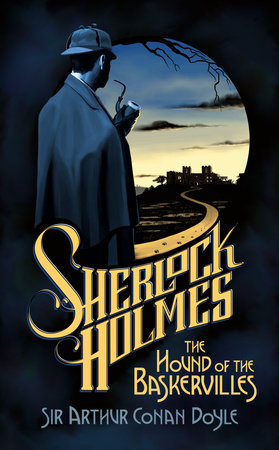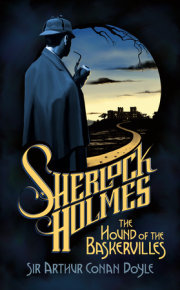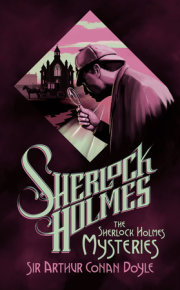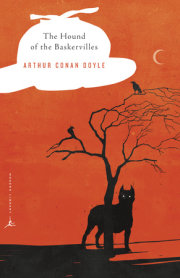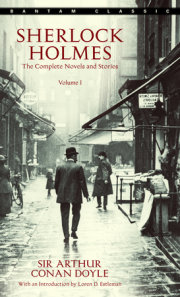Table of Contents
Title Page
Copyright Page
Dedication
Chapter 1 - Mr. Sherlock Holmes
Chapter 2 - The Curse of the Baskervilles
Chapter 3 - The Problem
Chapter 4 - Sir Henry Baskerville
Chapter 5 - Three Broken Threads
Chapter 6 - Baskerville Hall
Chapter 7 - The Stapletons of Merripit House
Chapter 8 - First Report of Dr. Watson
Chapter 9 - Second Report of Dr. Watson
Chapter 10 - Extract from the Diary of Dr. Watson
Chapter 11 - The Man on the Tor
Chapter 12 - Death on the Moor
Chapter 13 - Fixing the Nets
Chapter 14 - The Hound of the Baskervilles
Chapter 15 - A Retrospection
Afterword
Selected Bibliography
BIOGRAPHY AND CRITICISM
Sir Arthur Conan Doyle was born in Edinburgh in 1859. After nine years in Jesuit schools, he went to Edinburgh University, where he received a degree in medicine in 1881. He then became an eye specialist in Southsea, with a distressing lack of success. Hoping to augment his income, he wrote his first story, A Study in Scarlet. His detective, Sherlock Holmes, was modeled in part after Dr. Joseph Bell of the Edinburgh Infirmary, a man with spectacular powers of observation, analysis, and inference. Conan Doyle may have been influenced also by his admiration for the neat plots of Gaboriau and for Poe’s detective, M. Dupin. After several rejections, the story was sold to a British publisher for £25, and thus was born the world’s best-known and most-loved fictional detective. Fifty-nine more Sherlock Holmes adventures followed. Once, wearying of Holmes, his creator killed him off, but was forced by popular demand to resurrect him. Sir Arthur—he was knighted for his defense of the British cause in The Great Boer War—became an ardent spiritualist after the death of his son Kingsley, who had been wounded at the Somme in World War I. Sir Arthur Conan Doyle died in Sussex in 1930.
With more than ten million copies sold worldwide, Anne Perry is indisputably one of the world’s most popular mystery writers. She is noted for her memorable characters, historical accuracy, and exploration of social and ethical issues. Her story “Heroes” won the 2000 Edgar Award for the short story. She lives in a small fishing village on the remote North Sea coast of Scotland.
SIGNET CLASSICS
Published by New American Library, a division of
Penguin Group (USA) Inc., 375 Hudson Street,
New York, New York 10014, USA
Penguin Group (Canada), 90 Eglinton Avenue East, Suite 700, Toronto,
Ontario M4P 2Y3, Canada (a division of Pearson Penguin Canada Inc.)
Penguin Books Ltd., 80 Strand, London WC2R 0RL, England
Penguin Ireland, 25 St. Stephen’s Green, Dublin 2,
Ireland (a division of Penguin Books Ltd.)
Penguin Group (Australia), 250 Camberwell Road, Camberwell, Victoria 3124,
Australia (a division of Pearson Australia Group Pty. Ltd.)
Penguin Books India Pvt. Ltd., 11 Community Centre, Panchsheel Park,
New Delhi - 110 017, India
Penguin Group (NZ), 67 Apollo Drive, Rosedale, North Shore 0632,
New Zealand (a division of Pearson New Zealand Ltd.)
Penguin Books (South Africa) (Pty.) Ltd., 24 Sturdee Avenue,
Rosebank, Johannesburg 2196, South Africa
Penguin Books Ltd., Registered Offices:
80 Strand, London WC2R 0RL, England
Published by Signet Classics, an imprint of New American Library,
a division of Penguin Group (USA) Inc.
First Signet Classics Printing, July 1986
First Signet Classics Printing (Perry Afterword), July 2001
Afterword copyright © Anne Perry, 2001
eISBN : 978-1-101-09839-4
All rights reserved
REGISTERED TRADEMARK—MARCA REGISTRADA
The scanning, uploading, and distribution of this book via the Internet or via any other means without the permission of the publisher is illegal and punishable by law. Please purchase only authorized electronic editions, and do not participate in or encourage electronic piracy of copyrighted materials. Your support of the author’s rights is appreciated.
DEDICATION
MY DEAR ROBINSON: It was your account of a west country legend which first suggested the idea of this little tale to my mind. For this, and for the help which you gave me in its evolution, all thanks.
Yours most truly,
A. CONAN DOYLE
Chapter 1
Mr. Sherlock Holmes
MR. SHERLOCK HOLMES, who was usually very late in the mornings, save upon those not infrequent occasions when he was up all night, was seated at the breakfast table. I stood upon the hearth-rug and picked up the stick which our visitor had left behind him the night before. It was a fine, thick piece of wood, bulbous-headed, of the sort which is known as a “Penang lawyer.” Just under the head was a broad silver band, nearly an inch across. “To James Mortimer, M.R.C.S., from his friends of the C.C.H.,” was engraved upon it, with the date “1884.” It was just such a stick as the old-fashioned family practitioner used to carry—dignified, solid, and reassuring.
“Well, Watson, what do you make of it?”
Holmes was sitting with his back to me, and I had given him no sign of my occupation.
“How did you know what I was doing? I believe you have eyes in the back of your head.”
“I have, at least, a well-polished, silver-plated coffee-pot in front of me,” said he. “But, tell me, Watson, what do you make of our visitor’s stick? Since we have been so unfortunate as to miss him and have no notion of his errand, this accidental souvenir becomes of importance. Let me hear you reconstruct the man by an examination of it.”
“I think,” said I, following as far as I could the methods of my companion, “that Dr. Mortimer is a successful, elderly medical man, well-esteemed, since those who know him give him this mark of their appreciation.”
“Good!” said Holmes. “Excellent!”
“I think also that the probability is in favour of his being a country practitioner who does a great deal of his visiting on foot.”
. All rights reserved. No part of this excerpt may be reproduced or reprinted without permission in writing from the publisher.

